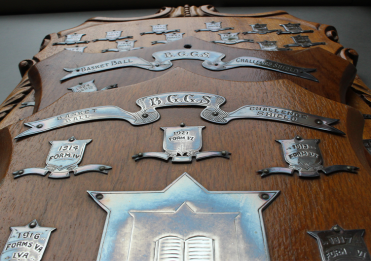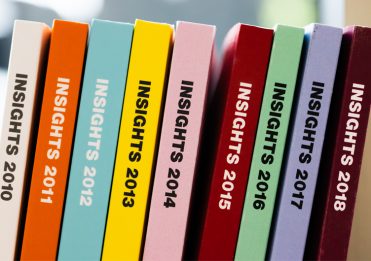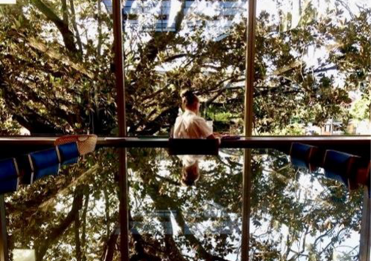Objects of Substance is designed to provoke memories, open ‘Pandora’s box’ on Girls Grammar history and, hopefully, explain events, ephemera, myths and significant others, while alluding to our philosophy.
A simple athletics or Girls’ Sports program, as it was known, printed each year by the Queensland Girls Secondary Sports Association (QGSSSA), may seem an unlikely object, though a timely one with the 103rd QGSSSA Track and Field Championships occurring this week. However, when this item also includes results dutifully recorded, the times achieved by athletes of every event, and the front and back pages covered in autographs, it provides fascinating insight into the 1957 Grammar girl and QGSSSA ‘sports’.

Elaine Harris’s 1957 program
The above program was the keepsake of Elaine Harris (1960), as a member of Form IIID in 1957. The School archives received it via Elaine’s sister, Yvonne’s (1956) granddaughter, Miranda Ripper (2011), a third generation Grammar girl. The School also holds Elaine’s programs from 1958, 1959 and 1960.

Elaine Harris in 1960
What does this program reveal about Elaine and the Grammar girl in 1957?
The first interesting detail noted was that the competition was held on Saturday 3 August—unlike the 2023 version, on Thursday 14 September. As it was a Saturday, the 1957 boarders attended, with little choice, although no doubt happy to have an outing. Day girls were given the option to attend to support their fellow students. A committed and supportive Grammar girl, Elaine Harris, was not a boarder and so elected, with more than half of her IIID class, to attend the athletics to support the Girls Grammar athletes. We know that IIID were great supporters as Elaine managed to get 28 autographs from her class of 40—three of whom were in the athletics squad: Janela Miller (1960); Sandra Astill (1960); and Sue Smith (1960). As the youngest age group in the School at the time—what modern Grammar girls would know as Year 9—this would have been the first athletics carnival the third formers would have had the opportunity to attend, and their enthusiasm was evident in the strength of their numbers.

1957 Athletics Team—Captain Madeleine Hamon holding the Stephens Cup. Eight athletes signed Elaine Harris’s sports program
The concept of collecting autographs from your friends and fellow students is an interesting phenomenon and closely linked to autograph books—a concept not as popular in 2023, but actually an activity that has its historical roots in the Renaissance. ‘The keeping of autograph books stems directly from the peripatetic Renaissance scholar’s practice of carrying about on his travels an album amicorum, a book suitably inscribed by his friends and patrons for his introduction and recommendations to others’ (Zola 1980). This habit morphed into the Victorian age fashion for ‘memory albums’ and, finally, into the autograph books predominantly kept by adolescent girls across the first half of the twentieth century. In the Girls Grammar world, as well as autograph books, the habit across the 1950s and ‘60s was for girls to collect autographs of fellow students, and sometimes staff, on QGSSSA events’ programs.

Patricia Stephenson’s 1957 Autograph Book signed by Barbara 'Bubbles' Bell.
There are a number of autographed Swimming and Athletics programs in the Girls Grammar archives. Interestingly, an autograph page has been an inclusion in the School Magazine since 2005. Previously, girls would often have friends and fellow students sign the inside covers, particularly in their final year.
The collection of autographs at sporting events also had the function of making the day more interesting and fun for the spectators who had no replays on the ‘big screen’ to witness what they might have missed, no mobile phones to take selfies and communicate with others, and less than strategically placed stands from which to observe their fellow students. The collection of these autographs provided entertainment for the spectator and even gave the opportunity for socialising with other schools. Elaine managed to acquire two signatures from Brisbane State High School girls, Nerida Field and Kay Knight—friends from primary school, perhaps.

1959 QGSSSA finish line at the Gabba
Elaine also collected the signatures of important athletes and School leaders on her 1957 program. Included in this group were: Helen Duffy (1957), Head Girl and Ida Woolcock Challenge Cup winner; Margaret Geach (1957), athlete and Prefect; and Barbara ‘Bubbles’ Bell (1958), athlete and Prefect in the following year. Elaine also collected the signature of fellow third former and outstanding athlete, Lynette Lewis (1960).

c1958 Boarders, Glenis Donaldson (1959) and Lynette Lewis (1960), in athletics uniform
Lyn Lewis, a boarder, was an exceptional sprinter and in her first year at the School in 1957, won the 75 yard Junior Championship and her age race. On Speech Day, she received the School’s prestigious Trustees Cup, the School Athletics Prize, and a Blue. In Lyn’s words: ‘I was a good runner before I went to (Girls) Grammar, representing Queensland at the National Athletics carnival held at Lang Park, and winning the Queensland Junior relay … In my later years, I became very friendly with both Marlene Matthews and Raelene Boyle, who both went on to great Olympics and Commonwealth Games success, and we have often discussed our times at the same ages, and I was running about the same time as them. So, who knows how my career would have progressed if I had been allowed professional training’ (Lewis, 26/08/23). Lyn went on to receive the School Athletics Prize in 1958, as well as a second Blue in 1959.

1958, shuttle relay at the Brisbane Cricket Ground
Elaine’s QGSSSA program, when compared with the Track and Field program of today, also sheds light on the changes in women’s sport and societal attitudes.
Sixty-six years ago, when Grammar athletes marched under their banner at the Brisbane Cricket Ground on Saturday 3 August, they had competed in 26 events. These events included ballgames (in 1957, this included File Gap, Captain Ball, Leaderball, and Tunnel and Zig-zag Pass), sprints from 60 yards to 220 yards, and shuttle relays. Age divisions were under 15 years and over, 15 years for relays and championships, and under 13 years to 17 years and over for 60 to 100-yard sprints. The schools competed for three cups: the Stephens Cup; the Senior Cup; and the Junior Cup, with points awarded to the top five schools in each event. This is an interesting point as there were 12 schools in QGSSSA at the time, which included Wynnum State High School (grey) and State Commercial High (mauve). Relays and championships were valued over regular sprints and ballgames, gaining extra points.

1959, March Past

QGSSSA Stephens Cup 1918-1971
The competition was controlled by male officials, including the announcer, Mr G Hardman from Brisbane radio station 4KQ. The two record keepers were women, Miss H Lisle and Miss R Jennings. The Association’s honorary secretary was Miss H Valttila, Brisbane State High School’s Athletics Coordinator, which was the habit within the Association where the honorary secretary role would rotate through the member schools. The ballgames judges were Physical Education students from The University of Queensland and the program cost one shilling.
In 2023, the athletes experience a vastly changed competition, as one would expect after six decades. Under the control of QGSSSA Executive Officer, Amy Anderton, they compete in 129 events across a full weekday. They will probably have no idea what ballgames are (in fact, ballgames became a separate competition in 1971 which then ceased to exist in 1996).
Both track and field events are held with age divisions ranging from 12 years and under to 17 years and over. There are six field events for the 13-17 age groups (four field events for the 12 and under age group), two divisions of circular—not shuttle—relays in all age groups, four multi-class events, hurdles for 13-17 years, and sprint distances over 100 to 400 metres for all age groups (with the exception of the 12 and under group). Middle and long-distance races are included, points are awarded to all competitors, and athletes compete for two trophies: the Stephens Cup and the Dell Mellefont Percentage Trophy, with an overall pennant for the aggregate winner and individual age division pennants. Greater gender equity prevails with the state athletics officials and, although the announcer is not from 4KQ, the Girls Grammar Director of Health and Physical Education, Mr Stephen Fogarty, is well-practised and knowledgeable in this role.

2022, 17 B Division relay—Annie Liu passing to Elodie Anthony
Over the years, the Directors of Sport and Physical Educators of QGSSSA schools have always tried to enhance every athlete’s experience by providing relevant, challenging, and inclusive competition, and cutting-edge coaching. It is also interesting to note other changes throughout the history of the association’s prodigious history. Thus, hurdles were reintroduced (an event found in the original QGSSSA Sports Day in 1918 but omitted across the years because of its physicality and ‘unladylike’ action, being reintroduced in 1971 and ’72, and again in 1976 after a break of three years), the 400 metre event was included in 1972, despite once deemed too challenging for the female athlete (and only introduced to the Olympics in Tokyo, 1964, where Australia’s Betty Cuthbert won a gold medal), and triple jump was introduced.

1924 hurdles demonstration by Molly Pratten, Grace Zillman and Joyce Guthrie

2002, Nicole Cheales (2004) leading at QGSSSA Athletics, Queensland Sport and Athletics Centre
Hopefully, the Year 10 supporters, who have traditionally attended the QGSSSA Athletics for a decade, were as interested and committed as Elaine Harris and her IIID classmates were in 1957. Autograph collection may be hampered by the fact that the programs given to the schools are fewer in number. Perhaps one diligent student will have recorded the results or added comments and an illustration or two. If so, it is hoped such a program may make its way into the Girls Grammar archive in years to come, continuing the tradition. Who knows, we may even have a few autographs to speculate on!
Pauline Harvey-Short (1971)
Manager, School History and Culture
References
Harvey-Short, P (2011) To become fine sportswomen. The history of Health, Physical Education and Sport at Brisbane Girls Grammar School, Brisbane Girls Grammar School.
Lewis, Lynette email 26.08.23.
Zola, M (1980) ‘By hook or by crook’: New look at the Autograph Book. New York Folklore, 6 (3), p 185-194.

Back cover of Elaine Harris’s 1957 QGSSSA Inter-school Girls’ Sports Program




